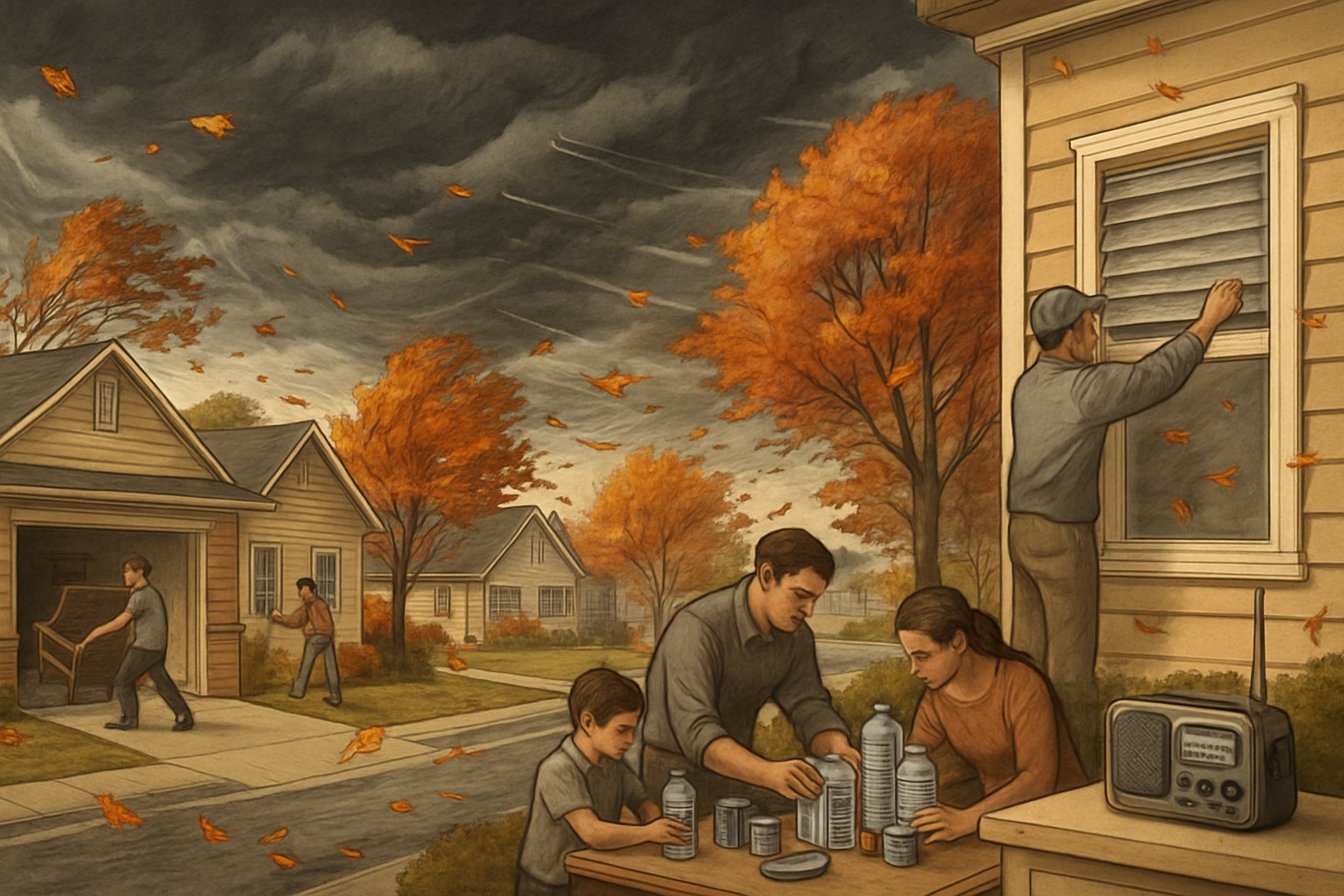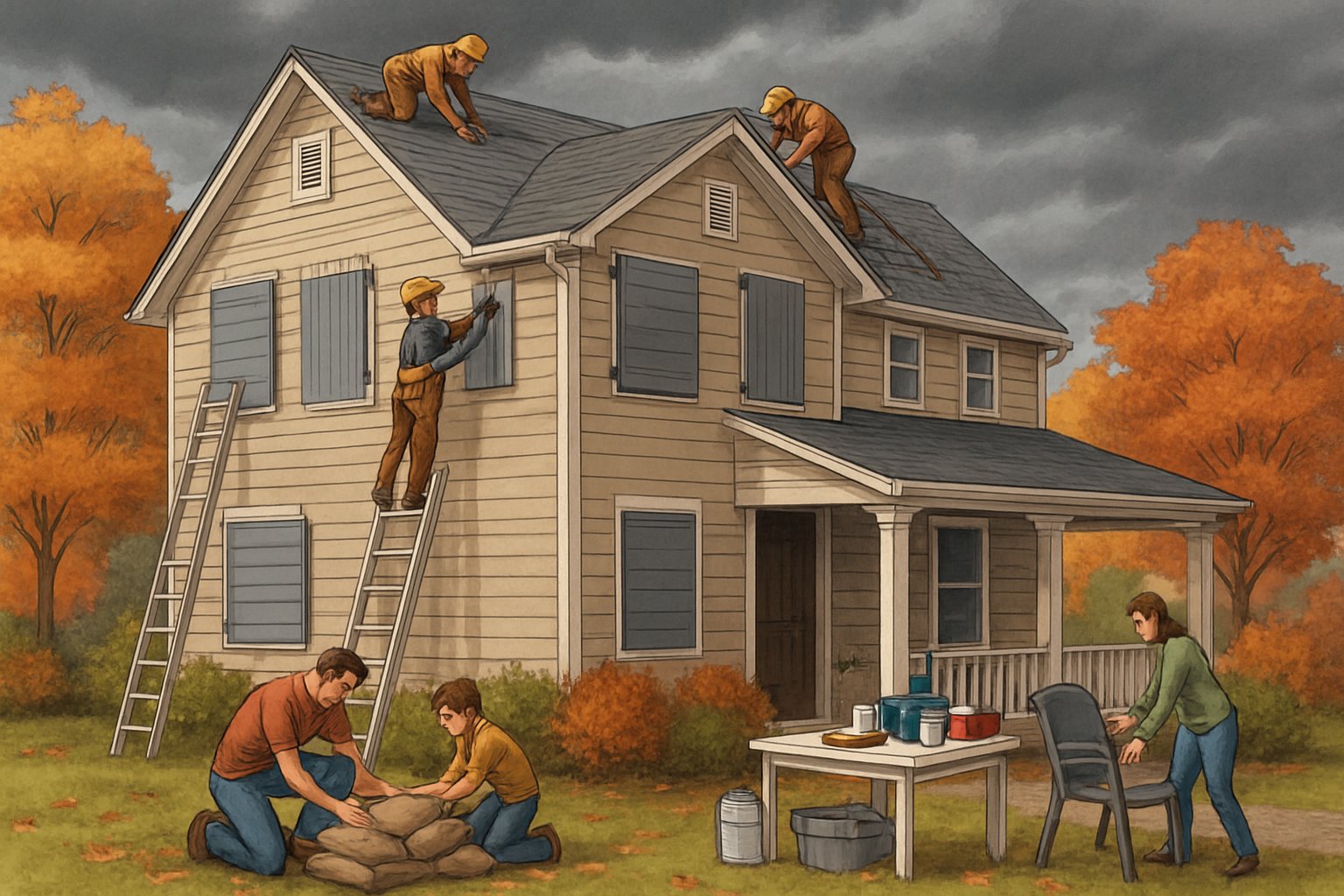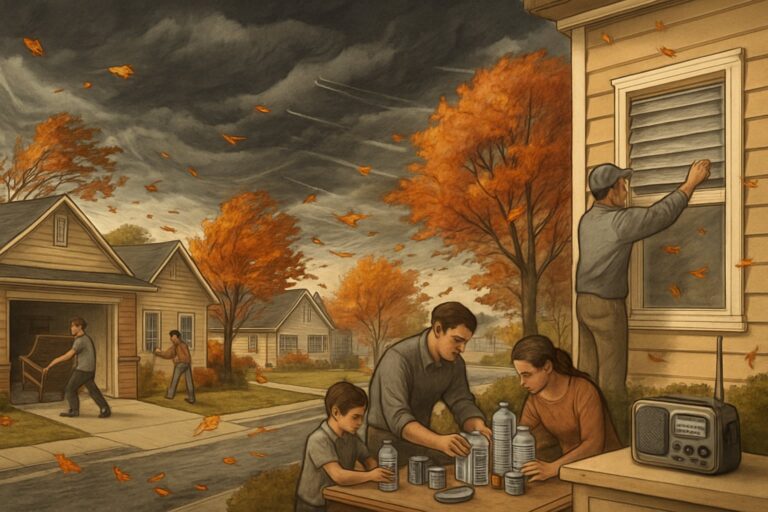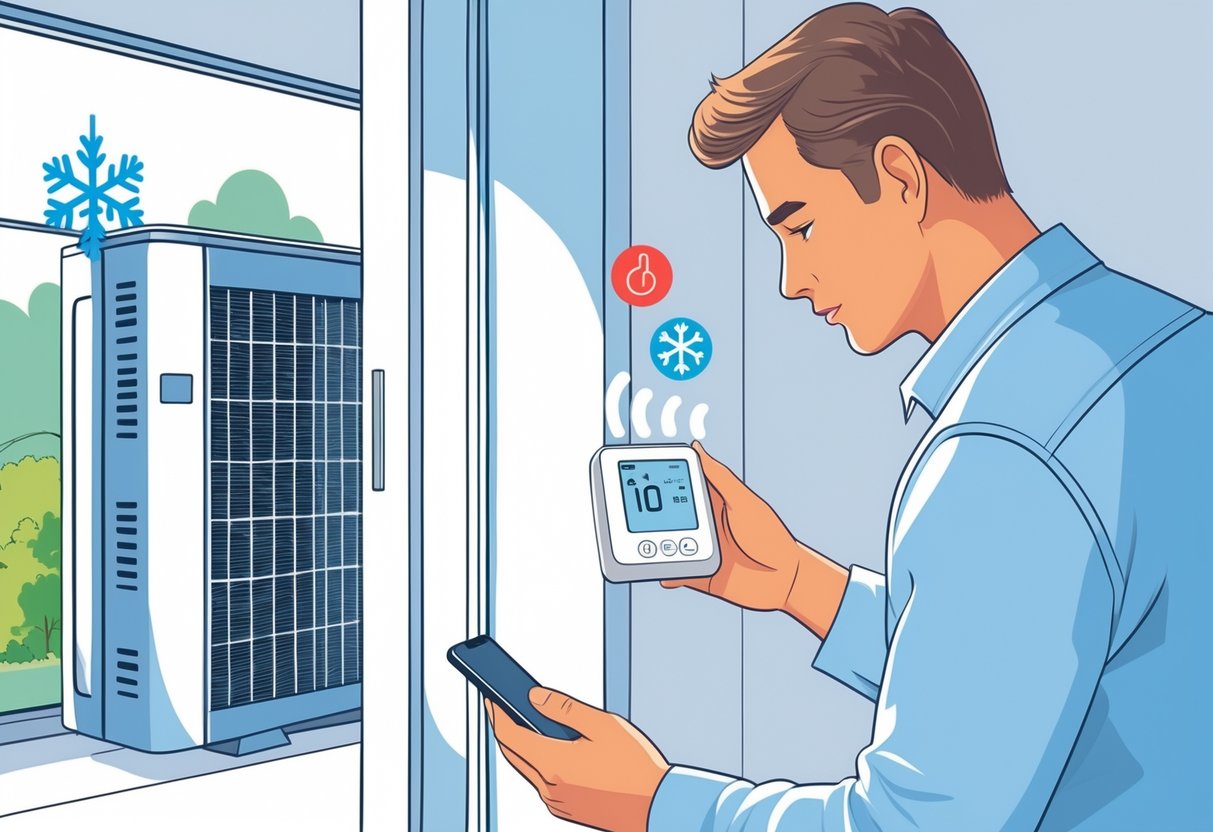Fall storm season in Missouri is a wild ride. Calm skies can turn into dangerous chaos in just a few hours.
The state faces all sorts of weather threats in autumn. Severe thunderstorms, tornadoes, ice storms, and flooding all show up and can seriously damage homes and property.

Getting ahead of storm season protects your family and property from costly damage and safety risks. If you live in Missouri, you should focus on things like home maintenance, emergency supplies, and safety plans to keep everyone safer when the weather gets nasty.
It’s smart to act early. If you wait for the weather alerts, you’ll probably end up scrambling—and that’s not when you want to realize you forgot batteries or your gutters are clogged.
Need a Home Fix – Emergency or Routine?
From leaks and no-heat nights to simple tune-ups, our 24/7 hotline connects you with trusted local pros in minutes.
Key Takeaways
- Fall storms in Missouri can develop fast and bring high winds, hail, and flooding
- Prepare your home with roof checks, emergency kits, and a family plan before the storms arrive
- Early prep saves money and keeps families safer when severe weather hits
Understanding Fall Storm Season In Missouri

Missouri gets a second round of severe weather in September and October. The jet stream shifts and temperature swings bring storms that don’t always look like spring’s tornado season.
Fall storms have their own hazards. Where you live in the state changes when and how hard you get hit.
Common Storm Hazards in Autumn
Autumn in Missouri brings a grab bag of dangerous weather. Tornadoes are the big worry in September and October.
Thunderstorms can pop up fast this time of year. They bring powerful winds and heavy rain, and flash flooding is a real problem when those storms roll through.
Hail isn’t rare in the fall either. Big hailstones can wreck cars, roofs, and crops. Missouri gets plenty of hail events in autumn, honestly more than you’d expect.
Temperatures jump all over the place. One day it’s warm, the next you’re dealing with frost. That’s rough on farmers and anyone planning outdoor stuff.
Lightning sticks around as a threat too. If you’re outside during a storm, you’re at risk, and power outages from lightning strikes aren’t unusual.
Why Fall Severe Weather Strikes Missouri
The jet stream is the main culprit behind Missouri’s wild fall weather. In autumn, it drops closer to mid-Missouri, setting the stage for severe storms.
When cool Canadian air collides with warm, humid southern air, things get unstable. That’s when the storms really start cooking up.
Honestly, spring storms are usually the worst, but fall can rival them. The jet stream’s position in September and October is a lot like what we see in April and May.
Mid-Missouri sits right in the crosshairs. Storms love to track through this area, especially as fronts stall out and keep the weather dicey.
Early fall still carries plenty of energy in the atmosphere. Summer’s leftover moisture just adds fuel to the fire.
Regional Differences Across the State
Northwestern Missouri usually gets the first taste of fall storms. Cooler temps and early frosts kick things off in mid-September.
Southeastern Missouri hangs onto warmer weather longer, so storms peak a little later. The growing season stretches into late October down there.
The Ozark Mountains mess with the usual weather patterns. Higher elevations change how and when storms hit, so timing and intensity shift in that region.
Mid-Missouri gets the steadiest storm activity. If you live there, expect a busy September and October, weather-wise.
First frost dates are all over the map. The north can freeze in early October, while the south might not see it until late in the month.
Assessing Your Storm Risks
If you know Missouri’s storm patterns and your own property’s weak spots, you’ll make smarter choices. Mid-Missouri, in particular, has its own set of headaches that call for a bit more planning.
Historical Weather Events and Patterns
Missouri gets hit with all kinds of severe weather in the fall. The state averages about 45-60 tornadoes a year, and plenty of those happen during the spring and fall transitions.
Common Fall Weather Threats:
- Severe thunderstorms with damaging winds
- Large hail events
- Flash flooding from heavy rainfall
- Ice storms in late fall and early winter
- Sudden temperature drops
Peak severe weather in Mid-Missouri usually runs from March through June. But fall storms can be sneakier—they move faster and don’t always give you much warning.
The state’s spot on the Great Plains means cold air from the north and warm, wet air from the south like to collide here.
Historical Patterns Show:
- September storms bring heavy rain and flooding
- October usually means more wind
- November is when ice storms start showing up
Identifying Local Storm Vulnerabilities
Take a look around your property. Stuff like big trees, nearby creeks, or even the slope of your yard changes how storms hit your home.
Key Vulnerability Factors:
- Large trees close to the house
- Poor drainage near the foundation
- Homes in flood-prone spots
- Properties on hills or in valleys
- Old or worn-out roofs
Mid-Missouri’s hills and valleys make things trickier. Water rushes into valleys and causes flash floods, while hilltops get hammered by wind.
Walk your property and look for trouble spots—dead branches, clogged gutters, places where water pools after rain.
Check with your local emergency management office for flood maps and past storm data. That’ll help you figure out your real risks.
Preparing Your Home For Fall Storms

Getting your place ready for Missouri’s fall storms means focusing on what’s most likely to get battered—your roof, windows, doors, gutters, and anything left outside.
Roof Maintenance and Reinforcement
Missouri’s fall storms really put roofs to the test. Walk around and look for missing, cracked, or loose shingles before the season hits.
Check for exposed nails or damaged flashing near chimneys and vents. Small issues can turn into major leaks fast.
Impact-resistant shingles do a better job against hail and wind. If you’re replacing your roof, maybe spring for Class 4 impact-resistant materials.
If you spot a lot of shingle granules in your gutters, that’s a sign your roof’s getting tired and might not make it through another stormy fall.
Trim any branches hanging over your roof. Those can snap off and do serious damage during a storm.
Pop into your attic and look for water stains or damp insulation. Fix leaks before the weather turns.
Securing Windows and Doors
Windows and doors are easy targets for wind and rain. High winds can shatter glass or push water through the tiniest cracks.
Go around your house and check the caulk on every window and door. Replace any that’s cracked or peeling with fresh, weatherproof sealant.
Make sure all window locks and door latches work and close tight. Don’t wait until a storm is on you to find out something’s loose.
For windows facing the direction storms usually come from, consider storm shutters. If that’s not in the budget, plywood cut to size will do in a pinch.
Check door frames for gaps where you can see light. Add weatherstripping to keep wind and rain outside.
Swap out cracked or loose window panes before storm season. Even a small crack can spell disaster in a windstorm.
Ensuring Functional Gutters and Downspouts
If your gutters are clogged, water will back up and wreck your roof, siding, or foundation. Don’t skip this step.
Clear out leaves, sticks, and anything else from gutters and downspouts. A quick blast with the hose will show if water’s flowing right.
Check for loose brackets or sagging spots. Tighten things up or add support where it’s needed.
Downspouts should dump water at least six feet from your foundation. If water pools near your house, add extensions.
Look for rust or holes in metal gutters. Patch small holes, but if a section’s in bad shape, just replace it.
Gutter guards help keep out leaves in the fall, which means less cleaning and fewer clogs during storms.
Protecting Outdoor Property
Anything outside can turn into a projectile in a storm. Secure or move stuff that might blow away.
Store patio furniture, grills, and decorations in a garage or shed. If you can’t move something big, anchor it down with straps or chains.
Trim dead branches from trees near your house. Fall storms love to bring those down, and they can wreck roofs, cars, or power lines.
Check fences and gates for loose parts. Fix them before the wind does it for you.
Move potted plants and yard decorations somewhere safe. Even small things can shatter windows if the wind picks up.
Secure trash cans with bungee cords or stash them somewhere out of the wind. Empty cans are notorious for blowing around and causing trouble.
Storm-Proofing Your Roof
A roof that’s ready for Missouri’s rough fall storms needs regular checkups, solid materials, and repairs before things get bad. These three steps can save you a lot of money and headaches later.
Visual Inspections and Professional Assessments
Take a good look at your roof at least once a year—ideally before storm season. That way, you’ve got time to fix anything while the weather’s still decent.
Check these spots:
- Missing or busted shingles
- Cracked or loose flashing around chimneys and vents
- Clogged or damaged gutters
- Sagging roof sections
Professional inspectors can spot problems you might miss. They use special tools to find hidden damage under the shingles or in the structure itself.
Local contractors know Missouri’s weather quirks and which materials hold up best. It’s worth asking for their advice if you’re not sure.
If you schedule inspections in good weather, you’ll avoid the last-minute rush when storms are on the radar. Plus, contractors will have more time to do the job right.
Upgrading to Impact-Resistant Shingles
Impact-resistant shingles give Missouri homes better protection against hail. These shingles meet strict testing standards for impact resistance.
Benefits include:
- Better hail damage resistance
- Longer lifespan than standard shingles
- Potential insurance premium discounts
- Enhanced wind resistance ratings
Class 4 impact-resistant shingles offer the highest level of protection. They can take hits from hailstones up to two inches wide without much damage.
Insurance companies often reward homeowners who install these shingles with discounts. That’s a nice bonus, honestly.
Make sure professionals install these shingles. If someone installs them wrong, you could lose your warranty and see problems during storms.
Addressing Minor Repairs Promptly
Small roofing issues can spiral out of control when storms hit. Fixing them before fall weather shows up can save a lot of money and stress.
Common minor repairs include:
- Replacing loose or missing shingles
- Sealing small leaks around penetrations
- Securing loose flashing
- Cleaning and repairing gutters
Water sneaks in through tiny gaps and spreads fast during storms. A tiny leak can quickly turn into a big headache inside your home.
Early repairs help protect insulation, drywall, and even the wiring. Fixing small stuff now costs way less than dealing with major storm damage later.
It’s smart to keep a list of reliable local contractors handy. That way, you’re not scrambling when you need quick help.
Emergency Preparedness For Families
Missouri families deal with all sorts of severe weather in the fall—tornadoes, floods, even ice storms. Having emergency plans, supply kits, and ways to communicate really helps when things get rough.
Developing a Family Emergency Plan
Every family should have a written plan for different types of severe weather. The plan needs to name safe spots in the house during tornadoes, like basements or interior rooms on the lowest floor.
Pick meeting places near your home and outside your neighborhood. These help everyone find each other if you get separated.
Important plan elements include:
- Primary and secondary evacuation routes
- Emergency contact information for all family members
- Special needs for elderly relatives, pets, or disabled family members
- School and workplace emergency procedures
Practice your plan twice a year. Try out situations like tornado warnings or flash flood alerts.
Keep copies of your plan in several places. Stick one in each car and give extras to relatives who live out of town.
Creating a Severe Weather Supply Kit
Families in Missouri should keep enough emergency supplies for three days. Storms can knock out power and block roads for a while.
Essential supply kit items:
- One gallon of water per person per day
- Non-perishable food for three days
- Battery-powered or hand-crank radio
- Flashlights and extra batteries
- First aid kit and prescription medications
- Cell phone chargers and backup power banks
Put your supplies in waterproof containers where you can grab them fast. Check food, water, and medicine expiration dates every six months.
Keep important documents—insurance, IDs, bank info—in waterproof bags. Cash in small bills is super useful if card systems go down.
Establishing Reliable Communication Methods
Families need several ways to stay in touch during storms. Phone lines and cell towers often go down in bad weather.
Pick an out-of-state contact who can pass along messages if local lines are down. Sometimes long-distance calls work when local ones don’t.
Communication tools to consider:
- Weather radios with NOAA alerts
- Text messaging (often works when calls fail)
- Social media apps that work offline
- Two-way radios for short-range contact
Save emergency numbers in everyone’s phones. Add local emergency management, utilities, and insurance contacts.
Teach kids how to call 911 and give their name and address. They should memorize at least one important number in case their phone stops working.
Staying Safe During And After Fall Storms
When storms hit mid-Missouri, knowing how to get alerts, find shelter, and check for damage can really make a difference. Quick action and a little planning can be lifesavers.
Monitoring Weather Alerts
Weather alerts give people a heads-up before a storm arrives. It’s smart to sign up for a few different alert systems so you don’t miss anything.
Primary Alert Sources:
- National Weather Service mobile alerts
- Local news apps and websites
- NOAA Weather Radio broadcasts
- Emergency management text alerts
Check the weather every few hours during storm season. Sometimes you only get a few minutes’ warning.
Key Warning Signs:
- Tornado watches and warnings
- Flash flood alerts
- Severe thunderstorm warnings
- High wind advisories
Mid-Missouri weather changes fast. Even if the sky looks fine, storms can sneak up in less than half an hour.
Taking Shelter and Evacuation Procedures
When storms roll in, getting to safety quickly matters. Different weather threats call for different shelter plans.
Tornado Safety:
- Go to the lowest floor of a building
- Stay in interior rooms away from windows
- Get under sturdy furniture if possible
- Avoid cars and mobile homes
Flood Safety:
- Move to higher ground immediately
- Never drive through flooded roads
- Stay away from storm drains and creeks
- Turn off electricity if water enters the home
Strong winds mean you should get inside a solid building right away. If winds hit 40 mph or more, it’s time to stop outdoor activities.
Know your evacuation routes before storms start. Keep your emergency kit ready with food, water, flashlights, and batteries.
Assessing Damage and Beginning Recovery
After a storm, new dangers pop up during cleanup. Broken buildings, power lines, and flooding are all risky.
Safety First Steps:
- Check for injuries and call 911 if needed
- Look for gas leaks and electrical damage
- Take photos of damage for insurance
- Contact utility companies about power lines
Don’t touch downed power lines or go into flooded areas. Water and electricity together are a deadly mix.
Cleanup Hazards:
- Broken glass and sharp metal
- Unstable trees and branches
- Contaminated flood water
- Carbon monoxide from generators
Let professionals handle big repairs. Insurance companies want photos and documentation before you start cleaning up.
Watch out for scammers after storms. Always double-check contractors and repair services before you hire anyone.
Frequently Asked Questions
Missouri residents have a lot of questions about storm prep in the fall. Here are some answers about supplies, home protection, safety, and where to get updates.
What are the essential supplies to stock up on before a fall storm in Missouri?
Get the basics before storms hit. Water comes first—store one gallon per person per day for at least three days.
Stock up on non-perishable foods that don’t need cooking. Canned goods, crackers, and dried fruit are handy. Don’t forget a manual can opener.
Have flashlights and extra batteries for emergencies. A battery-powered or hand-crank radio keeps you in the loop if power goes out.
First aid kits should have bandages, wipes, painkillers, and prescription meds. Keep important documents in waterproof containers too.
How can homeowners safeguard their property against potential storm damage?
Start with a roof check. Look for loose or missing shingles before fall storms arrive. Clean gutters and downspouts to stop water damage.
Trim tree branches over the house or power lines. Get rid of dead limbs that might fall in high winds.
Secure outdoor stuff like furniture, grills, and decorations. These things can turn into flying hazards. Put them in the garage or a shed if you can.
Protect windows during severe storms. Install storm shutters or keep plywood sheets ready to go.
What are the best practices for creating a family emergency plan before storm season?
Pick a safe room on the lowest level. Basements are best, but an interior ground-floor room works too for tornadoes.
Set up meeting spots inside and outside your neighborhood. Everyone should know where to go if you get split up.
Make contact cards with key phone numbers. Include emergency services, family, and an out-of-state contact.
Practice the plan with everyone. Kids especially need to know what to do during different types of storms.
Which government agencies or resources provide timely updates and warnings about Missouri storms?
The National Weather Service sends out official warnings and watches for Missouri. Their offices in Springfield, Kansas City, and St. Louis cover different regions.
Missouri Emergency Management Agency handles state disaster response. They post updates on social media and through local news.
Local emergency management offices give community-specific info. County and city services know the local risks and evacuation routes.
Weather apps and NOAA Weather Radio send automatic alerts. These tools push warnings straight to your phone or radio when storms approach.
What steps should be taken to ensure personal safety during a severe fall storm?
Go to your designated safe room as soon as tornado warnings sound. Stay away from windows and outside walls.
Don’t use electrical appliances during thunderstorms. Lightning can travel through wiring and cause fires or shocks.
Never drive through flooded roads. You can’t always tell how deep water is, and cars can get swept away in a flash.
Stay inside until authorities say it’s safe. Downed power lines and debris are still dangerous after the storm passes.
How can residents of Missouri stay informed about the progression of a fall storm?
NOAA Weather Radio gives weather updates around the clock. These radios still work if the power goes out, which is honestly a relief.
Local news stations usually have live storm tracking. They also share safety info you might need in a pinch.
Most stations now offer weather apps that send push notifications, so you don’t have to keep checking.
Emergency alert systems shoot messages straight to your phone if you’re in an affected area. You can’t block these, but that’s probably for the best.
Local emergency management offices post real-time updates on their social media. It’s smart to follow their official accounts when storms hit.







Leave a Reply